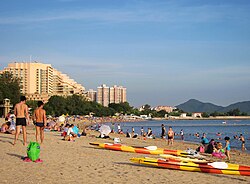Golden Beach (Hong Kong)
Golden Beach | |
|---|---|
Beach | |
 Golden Beach (background) viewed from Cafeteria New Beach in 2017 | |
| Location | So Kwun Wat, New Territories, Hong Kong |
| Dimensions | |
| • Length | 550 metres (1,800 ft) (approx.) |
| Patrolled by | Leisure and Cultural Services Department |
| Access | Castle Peak Road |
Golden Beach (Chinese: 黃金泳灘) is located at 18+1⁄2 miles of Castle Peak Road in So Kwun Wat, New Territories, Hong Kong. It is contiguous with the adjacent Cafeteria New Beach and Cafeteria Old Beach to its northwest.
Golden Beach is the largest public beach in Tuen Mun District with a total area of 78,500 m2 (845,000 sq ft) and a length of 545 metres (1,788 ft). The water quality is usually classified as Grade 2 (Fair). Tropical trees, like coconut, and flowers of various species are planted on both sides of a 480-metre-long (1,570 ft) promenade running parallel to the beach. Refreshment kiosks, a hotel, and a shopping centre are located adjacent to the beach.
There is a volleyball court at the beach, which is a unique feature amongst the beaches of Hong Kong. The Hong Kong national beach volleyball team occasionally practise on Golden Beach.
History
[edit]Golden Beach was one of the first artificial beaches constructed in Hong Kong, following the private beach at Tai Pak in Discovery Bay.[1] It was built in 1994 using about 74,000 cubic metres (2,600,000 cu ft) of sand.[2] It opened to the public in 1995, originally under the management of the Regional Council.[3][4]
In 2000, management of the beach was transferred to the newly formed Leisure and Cultural Services Department (LCSD).
Features
[edit]
- Changing rooms and showers
- Dolphin Square
- Restaurant
- Seaside promenade
- Toilets
- Tuck shop
Patronage
[edit]Golden Beach is the busiest of the six gazetted beaches in Tuen Mun District. In 2016, according to the LCSD, it had an average attendance of 1,941 on weekdays, 4,438 on weekends and holidays, and 670,350 during the bathing season. This makes it one of the most well-attended beaches in Hong Kong, behind only Repulse Bay, Shek O, and Clear Water Bay Second beaches.[5]
Environmental issues
[edit]Marine refuse
[edit]Like many other beaches in Hong Kong, Golden Beach suffers from a worsening problem with marine refuse. On occasion, vast amounts of garbage suddenly wash up on the beach. The rubbish often bears Simplified Chinese characters, leading citizens to suspect that it originates from Mainland Chinese ships.[6] On 1 August 2017, more than 18 lorry-loads worth of rubbish washed up on the beach in one 24-hour period.[7]
Sand loss
[edit]
The beach suffers from serious loss of sand, and has shrunk significantly over the past two decades.[8] The bases of several lookout towers, which were once set well back from the water line, are now exposed to the sea. In April 1999, the beach was replenished with about 7,900 cubic metres of sand.[2]
The Civil Engineering and Development Department (CEDD) and Halcrow Group analysed aerial imagery taken from 2001 to 2008 and found that Golden Beach eroded by up to two metres per year, affecting its recreational value. The study found that the high rate of sand loss is driven by the fact that Golden Beach is situated oblique to the prevailing wave direction. This has caused sand to migrate north, in an anti-clockwise direction, such that the southern end of the beach has completely been eroded.[2]
The LCSD had to close part of the beach in 2008 as the problem worsened.[9] After Typhoon Hagupit hit Hong Kong in September 2008, the LCSD hired the CEDD to conduct remedial works at Golden Beach, at a cost of HK$7.2 million. This included replenishment of sand, construction of gabion walls, and construction of groynes. These improvements were made from 2009 to 2011.[8] Still, Golden Beach is smaller than its original size and length.[how?]
Water quality
[edit]The Environmental Protection Department conducts water quality testing at Golden Beach at least three times per month, year-round.[5] The department uses a four-point grading system to reflect water quality, where Grade 1 (Good) reflects the best quality. During the 1990s, the water quality at Golden Beach consistently ranked as Grade 3 (Poor). Various sewerage infrastructure improvements have helped boost the quality to an average of Grade 2 (Fair) since the turn of the millennium.[10][5]
During the 2016 swimming season, the water quality ranked Grade 2 (Fair) for about 85 per cent of tests, and Grade 1 (Good) about 15 per cent of the time.[5][needs update]
See also
[edit]References
[edit]- ^ "Man-made beach for Tuen Mun". South China Morning Post. 26 August 1991. p. 2.
- ^ a b c Johnson, Hakeem; Shek, Peter; Lee, Francis (24 November 2011). "Analysis of the causes of sediment loss at Golden Beach, Hong Kong". Asian and Pacific Coasts 2011: Proceedings of the 6th International Conference on APAC 2011: 299–306. doi:10.1142/9789814366489_0034. ISBN 978-981-4366-48-9.
- ^ "New beaches". South China Morning Post. 20 October 1994. p. 6.
- ^ "Report on Bacteriological Water Quality of Bathing Beaches in Hong Kong 1995". Regional Council. 20 December 1995.
- ^ a b c d "Beach Water Quality in Hong Kong" (PDF). Environmental Protection Department. 2016.
- ^ "網民熱話:黃金泳灘變垃圾灣 垃圾長龍嚇人". Oriental Daily News. 1 August 2017.
- ^ Cheng, Kris (2 August 2017). "'18 truckloads of trash': Golden Beach in Tuen Mun swamped with rubbish". Hong Kong Free Press.
- ^ a b "LCQ11: Flow of marine sand at public beaches". Government of Hong Kong. 18 June 2014.
- ^ So, Peter (25 April 2009). "Barriers to prevent loss of sand at beaches in Tuen Mun, Lantau". South China Morning Post.
- ^ "Golden Beach". Beach Water Quality. Environmental Protection Department. Retrieved 7 August 2017.
